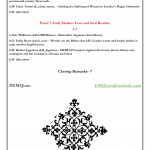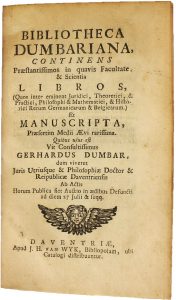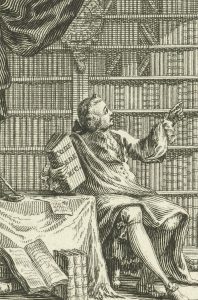Due to the COVID-19 pandemic, all spring and summer conferences were either cancelled or postponed. To have some sort of substitution, MEDIATE (represented by @R_Jagersma) participated in an online alternative on Twitter: Early Modern Quonference.
Organisation: @EMQuon2020 (website)
Hashtag: #EMQuon
The programme:



Below you’ll find our Tweets and the source of the used images.
Welcome at the last @EMQuon2020 session. I am Rindert Jagersma, and I am part of the @MEDIATE18C team, an ERC-funded project based at @Radboud_Uni. We study the circulation of books and ideas in 18C Europe by drawing on a database of private library (sale) catalogues #EMQuon 1/15
Image: Catalogue Pieter Burman (the elder) (Leiden, 1742) Photo: Joanna Rozendaal
In the MEDIATE project, we study private library sale catalogues from the Dutch Republic (@R_Jagersma), British Isles (@j_reboul), France (@HelwiB), Italy (@EvelienChayes) published between 1665-1830. The PI is professor Alicia Montoya #bookhistory #EMQuon 2/15
Image: Catalogue Gerhard Dumbar (Deventer, 1746) Photo: Joanna Rozendaal
Our PhD students study Hebrew and Jewish books (Anna de Wilde) and female book ownership (Joanna Rozendaal) in Dutch catalogues. @MEDIATE18C looks at smaller book collections (≤ 1000 books) to answer the question what people read during the age of Enlightenment #EMQuon 3/15
Image of a reading woman (MEDIATE18.nl)
Catalogues are a rich but tricky source. They show which books people had on their shelves, but as everyone knows, not all books owned are books read. Furthermore, books could be left out of catalogues by heirs or secretly added by booksellers (unsold remainders) #EMQuon 4/15
Image: Catalogue Gerhard Dumbar (Deventer, 1746) Photo: Joanna Rozendaal
Despite these pitfalls, catalogues are a rich source that provide intimate insight in the lives of people. Besides books, but also items such as zoological specimens, pistols, globes, medical equipment, bookcases, clothes, microscopes and even #unicorns are recorded #EMQuon 5/15
Image: Catalogus van eene fraaie verzaameling van welgeconditioneerde Nederduitsche boeken […] Den Heer Cornelis Cardinaal […] 1805 (UvA, O 65-1804)
Currently our database contains almost 550 catalogues and 500.000 transcribed and fully searchable items. In 2021, an #openaccess sandbox will become available for everyone to answer questions like: which books did collector X have, and how often does author Y occur? #EMQuon 6/15
Image: Keizerlijke bibliotheek en rariteitenkabinet (Jan Luyken, 1696) (detail)
Rijksstudio, Rijksmuseum, Amsterdam: https://www.rijksmuseum.nl/nl/collectie/RP-P-1896-A-19368-288
Or: if a collector had books from author A in his/her bookcase, what is the chance we will find author B? What are the characteristics of a provincial collection? By creating typologies of readers, we can provide insight in which patterns occur in book ownership #EMQuon 7/15
Image: Man in bibliotheek (Simon Fokke, 1751) (detail)
Rijksstudio, Rijksmuseum, Amsterdam: https://www.rijksmuseum.nl/nl/collectie/RP-P-OB-50.862
A lot of our work consists of matching the right author to the items described in catalogues. This can be straightforward, but often the description of items is vague. We spend a lot of time trying to identify the correct author. For example, in the case of #Spinoza #EMQuon 8/15
Images based on the catalogues of: Meggot 1693 (London); Kempen 1695 (Leiden); Mariette 1775 (Paris); Bronsart 1699 (Leiden).
The ‘rank person’-function in the database allows for identifying prominent authors: it shows how frequently their works appear in the catalogues. The most common stem from the classical antiquity. Such as Cicero, Horace and Virgil. Note: this work in progress and preliminary results #EMQuon 9/15
Image: Virgilius, Cicero en Seneca bij Grammatica met leerlingen (Jacobus Harrewijn, 1694) (detail)
Rijksstudio, Rijksmuseum, Amsterdam: https://www.rijksmuseum.nl/nl/collectie/RP-P-1904-510
Of the more ‘contemporary’ authors we find Grotius, Erasmus and Voltaire high up in the ranking. Furthermore, we look at translators. One of the most often occurring translators is Anne Dacier. Her name appears more often than the leading female author; Sappho #EMQuon 10/15
Image: Madame Dacier by Marie-Victoire Jaquotot
Wikimedia: https://en.wikipedia.org/wiki/File:Madame_Dacier_by_Marie_Victoire_Jaquotot.jpg
The most frequently listed titles are, not surprisingly, sacred texts (#Bible, bible books, and #Quran). And so-called ‘unspecified books’: packages filled with books and pamphlets, which were simply not worth the time and effort to mention each as a separate item #EMQuon 11/15
Image: Stilleven met boeken, Jan Davidsz. de Heem, 1625 – 1630 (detail)
Rijksstudio, Rijksmuseum, Amsterdam: https://www.rijksmuseum.nl/nl/collectie/SK-A-2565
Some book owners were real bibliophiles. We find nice collections of rare books, expensive bindings, and medieval manuscripts. Such as Jean Constantijn van Alderwerelt who owned 7 incunables. Some of those can be traced back to the collection of @KB_Nederland #EMQuon 12/15
Image: Epistolae et Evangelia (1481) (detail)
See: https://opc-kb.oclc.org/DB=1/XMLPRS=Y/PPN?PPN=325803242
Screenshot from Archive.org (https://archive.org/details/ned-kbn-all-00001849-001)
Fun fact: while catalogues offer so-called ‘rare books’, the catalogues are now often rare themselves. The survival rate of this type of disposable printed matter is low. In the Netherlands, this is about 16%. More than 2.000 Dutch catalogues exist as unique copies #EMQuon 13/15
Image: Veiling, anoniem, 1800 – ca. 1850 (detail)
Rijksstudio, Rijksmuseum, Amsterdam: https://www.rijksmuseum.nl/nl/collectie/RP-P-2015-26-458
The book sales catalogues were created to sell books. These auctions often took several days. Waiting for the right lot to come up could be tedious. Some people easily got bored and started #doodling in their catalogues. Such as this portrait or game of tic-tac-toe #EMQuon 14/15
See: http://bibliomediator.nl/2018/10/08/the-tic-tac-toe-doodle/
To conclude, I would like to mention our recently published article on the catalogue of Joanna #Koerten, one of the most famous artists of her time. This article is #openaccess https://brill.com/view/journals/qua/50/1-2/article-p109_7.xml Thank you for attending. If you have questions, let us know #EMQuon 15/15
Image: Portret van de knipkunstenares Johanna Koerten, Pieter Schenk (I), naar David van der Plas, 1701 (detail)
Rijksstudio, Rijksmuseum, Amsterdam: http://hdl.handle.net/10934/RM0001.COLLECT.44935
.
















